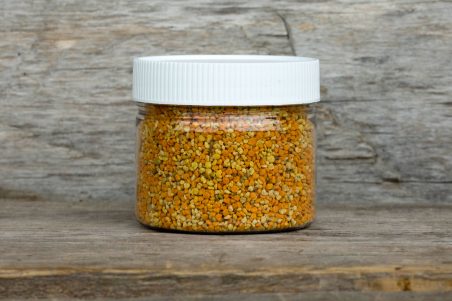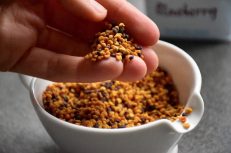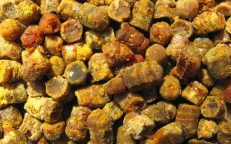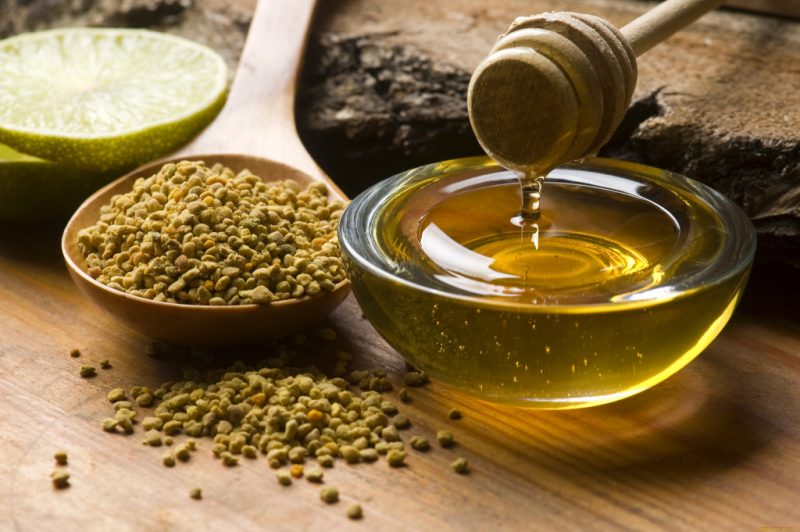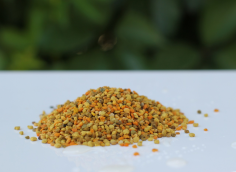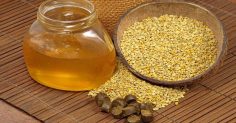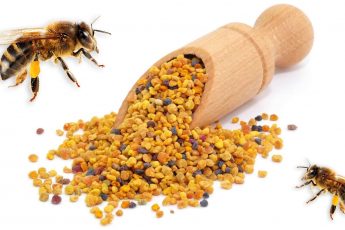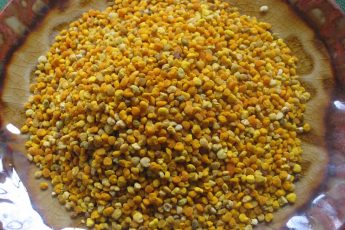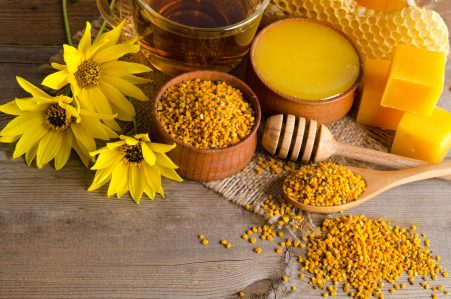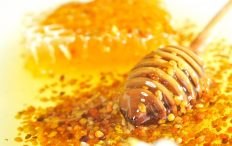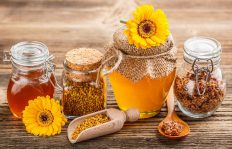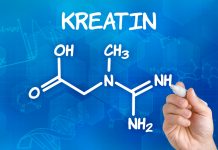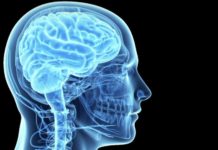Honey and propolis are far from the only products that we owe to bees, in addition to them there is also bee pollen. Its useful properties and methods of taking this natural medicine have been known to beekeepers since ancient times. A small teaspoon of this product contains many times more useful trace elements than in honey.
Material Content:
The chemical composition of bee pollen
Bee pollen, as each biology class remembers, is formed on flowers with the anthers that surround the pestle. Flying from flower to flower, a bee collects pollen on its paws to feed its offspring and transfers it to the hive. On the legs of the bees there are special baskets where pollen gets and stray into dense lumps. It is because of the collection method that pollen is also called pollen.
People know how to collect pollen not only from hives, but also directly from flowers, but it is the bee that is most valuable.
Its great benefit is provided by the special property of bees to collect pollen from different plants, mixing those species that are rich in various trace elements. Therefore, the resulting lumps are perfectly balanced in composition and have all the necessary nutrients.
It is necessary to dwell on the composition in more detail, since it is for him that pollen is valued by man.
100 grams of product contains:
- from 7 to 35% protein, and this protein is more beneficial in terms of amino acids than meat or milk;
- fats or lipids - up to 1.5 to 20%;
- carbohydrates (fructose and maltose) - from 20 to 38%.
The scatter in the values is due to the fact that pollen of different plants may have a different set of trace elements.
In addition to the listed proteins, fats and carbohydrates, pollen is rich in vitamins, namely:
- B vitamins (thiamine, riboflavin, nicotinic, folic and pantothenic acids);
- ascorbic acid;
- biotin;
- carotenoids, which in the human body turn into vitamin A.
In addition to vitamins, pollen and many minerals, such as potassium, calcium, phosphorus, magnesium, iron, manganese, silver and many others. Do not forget about phenolic compounds, which have anti-inflammatory, capillary-strengthening, bile and diuretic properties.
The enumeration of all the constituents of pollen is not so convincing without a designation of how exactly all these elements are useful to humans.
One of the main advantages of pollen is immunostimulating properties. The balance of vitamins and minerals helps the body resist disease and helps cope with colds and viruses.
Also, pollen can be introduced into the diet of diabetics, because unlike honey, it does not have sugars that are contraindicated in this disease.
Pollen also helps with gastrointestinal diseases, for example, with gastritis, constipation, and ulcers. A vitamin charge will help with problems in neurology - normalize sleep, relieve symptoms of depression, nervous exhaustion.
Also, the healing properties of pollen can be different for men and women, as well as for children.
For men
For the male body, the value of bee pollen is primarily in helping its reproductive system. The beekeeping product helps to fight impotence and prostatitis, and in the most effective way, namely, not allowing the prostate to narrow, reducing discomfort and pain, and reducing the number of nighttime urination. In addition, pollen prevents cell mutation, which can lead to oncology.
And for men of reproductive age, pollen can help increase the number of active sperm and improve the chances of conception.
For women
Pollen can also be beneficial for reproductive function and the female body. Folic acid, which is part of it, is indispensable in preparing for pregnancy and bearing. And for those women who have already come out of reproductive age, pollen will help to cope with the symptoms of menopause - vitamins and zinc will help prolong the youth of tissues.
Very good trim also affects the problem of excess weight. The thing is that this product normalizes metabolism, compensates for the lack of vitamins and saturates the body with energy, reducing appetite.
For children
Pollen will help those mothers whose children do not recognize vegetables and fruits. It’s not difficult to mix a spoonful of vitamin powder in your favorite dish, but the child will receive all the vital elements. But remember that doctors do not recommend starting to give pollen to children under four years of age.
In addition, it helps a growing and developing body strengthen the cardiovascular muscle, support the immune system, normalize sleep, reduce excitability, and strengthen bone tissue.
How to take pollen correctly?
It is necessary to take pollen inside, but depending on the plants from which it was collected, the taste of pollen can be either sweet or bitter. It is best to take pollen in the form of dried lumps, as it is obtained in an apiary. You can grind it into powder. If it’s difficult for you to use it in its pure form, mix it with honey or butter. It is acceptable to mix the crushed pollen in cold water or juice, however, this method will make the product the least useful. But breeding it with hot water will kill all the beneficial properties.
Pollen retains its beneficial properties for 18 months from the moment of collection, and then loses all trace elements, remaining only a source of a large amount of protein. But the pollen, immediately after harvest, filled with fresh honey, retains its healing properties longer.
For an adult, the norm of admission for prophylactic purposes and to maintain immunity is 15 grams of bread per day. If treatment of diseases is required, then the norm can be increased to 30 grams, but be careful - exceeding the dose can lead to allergic reactions and overdose.But this will not bring much benefit - the elements in the pollen are not accumulated by the body, but they are absorbed exactly as much as the body needs per day, so there is no sense in higher doses.
Children's dose:
- 4-7 years - 5 grams;
- 8-12 years old - 8 grams;
- 12-16 years old - 12 grams.
Pollen should be taken on an empty stomach, and it is better to start eating no earlier than half an hour later. Put pollen under the tongue and suck. In contact with saliva, it activates all its properties faster and is absorbed through the mucous membrane.
Traditional medicine recipes with bee pollen
The properties of pollen to support immunity will help not only to resist the risk of getting sick, but also to cope with a cold or flu that has already begun. It will support not only general, but also local immunity, because absorbable pollen, first of all, will help a sore throat and nasopharynx.
You can also prepare a cocktail, which is an excellent immunostimulant - for one serving, take half a banana, a teaspoon of honey and pollen, 200 ml of milk and whisk it all in a blender.
For patients with gastritis or an ulcer, a herbal decoction is well suited. With increased acidity, brew St. John's wort, mint, caraway seeds, and with a lowered peel of orange, wormwood, centaury. Take any of these decoctions with pollen to enhance the action of both components.
In addition to ingestion, pollen is used in home cosmetology, adding to masks. Mix, for example, 1 egg, 1 tablespoon of honey and 1 teaspoon. Thicken the composition with two tablespoons of flour and apply on the face. Wash off after 10 minutes and enjoy the fresh radiant skin, renewed with a vitamin composition.
Contraindications and possible harm
Like any product rich in various elements, pollen can be harmful if taken improperly or with individual intolerance. Such cases include an allergy to beekeeping products. Reception is not recommended for people with blood coagulation disorders and liver problems - a high content of vitamin A destroys the cellular structure of the liver, which is detrimental in one and the other disease.
Excessive intake of pollen can lead to hypervitaminosis, especially in children, as well as allergies and sleep disturbances and pressure surges. Therefore, it is worth starting the first dose with small doses, gradually increasing them, but not exceeding the recommended daily intake. In order not to overexcite the body with a shock dose of vitamins and not disturb sleep, take a natural medicine no later than 3 hours before bedtime.



